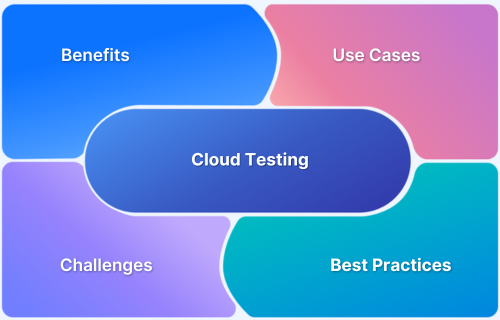In the fast-changing world of software development, cloud testing plays a crucial role in guaranteeing the strength, scalability, and security of applications. It involves using cloud computing services to assess software. Through this approach, development teams gain access to digital remote testing environments for their work. The testing processes enhance their speed while reducing costs and enabling scalability and flexibility directly due to the elimination of expensive software and hardware infrastructure maintenance.
The evaluation of applications through cloud testing occurs across multiple devices and operating systems and network configurations. The testing confirms that the software performs and operates as expected when used in realistic circumstances. Organisations that introduce cloud testing obtain better software quality while reducing development costs and accelerating their release times.
In this article, we will highlight the benefits of cloud testing and its impact on scalable software delivery. We will also discuss the different types of cloud testing available. Furthermore, we will address some of the challenges associated with testing in cloud environments and present effective strategies to tackle these issues.
Understanding Cloud Testing
Cloud testing involves evaluating software within cloud computing environments and infrastructures. The solution provides inexpensive and flexible testing conditions that utilise cloud infrastructure capabilities to offer scalable operations. Organisations must handle their own hardware and software systems when using conventional testing methods. Cloud testing enables teams to access testing resources that vendors provide through their cloud infrastructure.
Cloud-based services allow organisations to execute functional testing together with performance testing and security testing. This approach allows software development teams to efficiently and rapidly assess their applications and services across a variety of simulated environments, aiding in the detection and resolution of problems before they affect end users.
Benefits of Cloud Testing for Scalable Software Delivery
Utilising cloud testing enables faster application development by eliminating the constraints of on-premise development. This approach offers testers the ability to adapt testing resources based on project demands effortlessly. They can quickly increase or decrease resources to align with evolving project requirements. Such flexibility enables organisations to effectively handle fluctuating workloads.
Cost Savings
By employing pay-as-you-go pricing frameworks, organisations can minimise their expenditures on infrastructure with no maintenance costs. This method helps conserve resources by charging only for the resources utilised, making it a viable option for enterprises of all sizes.
Smooth Integration with CI/CD
Cloud testing platforms enable continuous feedback and faster software development cycles. They interface with CI/CD pipelines and tools to automate tests with each code change or deployment.
Utilise Fewer Resources
Cloud testing significantly shortens the testing duration needed for complex applications. Automated cloud testing offers a higher return on investment than traditional approaches. This is because of its flexibility and scalability. Furthermore, the resources utilised are significantly less, which further enhances the return on investment.
Accelerated Testing
Cloud-based testing accelerates the testing workflow by supplying on-demand resources, enabling teams to expedite their testing processes. The result of this approach leads to faster releases, which happen with reduced development cycles.
Enhanced Collaboration
Cloud-based tools with sharing capabilities enhance teamwork, which results in better collaboration and improved communication, and testing outcomes.
Efficient Disaster Recovery
Cloud-based software testing provides dependable and user-friendly backup functionalities. Testers can protect their data with ease, as cloud services ensure their information is backed up and easily recoverable after any disaster with just a few clicks.
Scalability
Cloud testing provides significant scalability and a more effective testing cycle. The demand for greater scalability necessitates faster, more efficient testing methods that can overwhelm traditional practices. Cloud testing is well-suited to meet such demands. It enables enhanced mobility, ensuring that physical limitations do not hinder the development and testing processes when utilising the cloud.
Global Access
Cloud testing can be utilised by remote teams located in various parts of the world. They can access various devices concurrently, without any interference among participants. This greatly diminishes the necessity for extensive infrastructure, saving a considerable amount of money. This testing approach is also very cost-efficient due to its adaptability and compatibility with different systems.
Streamlined Software Integration
Cloud-based testing gives testers significant flexibility in determining how and where to evaluate their software. When selecting a cloud type, it’s important to consider budget constraints, as public clouds are suitable for economical solutions.
Automatic Upgrades
New devices are automatically incorporated into the cloud as they are released, keeping the testing grid updated. Cloud test providers manage updates, allowing teams to concentrate on other aspects of their web application without the burden of maintaining manually.
Types of Cloud Testing
System Testing
The testing phase checks the complete cloud system to validate application features. It examines each element along with its relationship patterns in the cloud framework.
Interoperability Testing
Confirms that the application’s performance remains stable despite modifications to its infrastructure. It verifies that the application interacts correctly with other cloud services, APIs, or environments.
Performance Testing
The evaluation process determines how the cloud system performs under different workload conditions to maintain its speed and responsiveness. The process identifies critical performance factors and operational barriers and reveals affected zones that need improvement.
Availability Testing
Confirms that the cloud system remains accessible around the clock, guaranteeing that no service is affected from the user’s perspective. This ensures that users can utilise services without unexpected interruptions.
Multi-Tenancy Testing
Verifies that the cloud system can effectively support multiple users sharing the same resources without compromising performance. It ensures data security and isolation between tenants.
Security Testing
The testing process verifies both cloud data security and service protection against unauthorised access or breaches. The protection of sensitive user information, together with privacy, requires the implementation of encryption.
Disaster Recovery Testing
Simulates failures to evaluate the system’s capability to quickly recover after disruptions caused by network outages or increased load. This assesses how swiftly crucial data and services can be restored.
Browser Performance Testing
Analyse how effectively the cloud application operates across various web browsers, ensuring a uniform user experience. This checks for compatibility issues that may impact performance
Challenges of Testing in the Cloud
- Organisations face security risks when storing and testing confidential information in cloud environments. These risks are heightened when operating under strict data protection regulations. Security protocols need to be implemented strongly for protection.
- The testing environment in the cloud has performance implications which depend on network connection speed and server physical location. Performance evaluations together with real-time applications become negatively affected when delays and interruptions occur because of network speed and server location challenges.
- As the cloud infrastructure is overseen by the cloud service provider, users possess diminished control over updates, maintenance, or customisation, which could lead to challenges in meeting specific testing requirements.
- Cloud-based testing is heavily dependent on consistent Internet access. Disruptions in network connectivity will negatively affect testing operations and potentially slow down the process.
- Moving to a different cloud provider can be complicated. It can also be expensive, especially when there is a deep integration with the vendor’s tools and services.
- Although cloud-based testing may seem more affordable, there could be extra costs for bandwidth, storage, or unexpected scalability that may not be immediately apparent.
- The deployment location, together with infrastructure from cloud providers, creates performance instability that leads to inconsistent testing results.
- Cloud-based testing environments can be difficult to ensure compliance with industry standards and regulations. This difficulty arises because cloud providers may not meet all legal requirements.
Effective Strategies for Cloud-Integrated Testing
To fully leverage cloud-based testing while overcoming its unique challenges, teams need well-planned strategies. Below are some effective strategies for cloud-integrated testing, helping ensure reliability, speed, and scalability.
Choose the Appropriate Cloud Environment
The choice of cloud environment should match testing needs and financial limitations between public, private and hybrid cloud infrastructure. Every factor concerning data sensitivity and scalability, and long-term costs should be considered for this decision.
Choosing the appropriate cloud testing platform is crucial for matching testing requirements with available cloud resources. LambdaTest is a cloud platform that enables organisations to overcome the restrictions of on-premises testing while also benefiting from the flexibility, scalability, and cost-effectiveness. They can do this without sacrificing resources, overcoming restrictions like OS coverage, devices, and browsers.
LambdaTest is an AI-native test execution and orchestration platform that allows testers to perform manual and automated tests at scale. Its online Selenium Grid enables testers to conduct real-time and automated testing of Selenium ChromeDriver across more than 3000 environments, including real mobile devices and browsers. This ensures thorough cross-browser and cross-device testing. LambdaTest offers SmartWait to address Selenium synchronization issues. This feature enhances test efficiency and accuracy by enabling actionability checks before interacting with webpage elements.
LambdaTest integrates seamlessly with CI/CD pipelines like Jenkins, GitHub Actions, and Azure. This integration enables continuous testing. The platform offers solutions for managing test cases, tracking results, and enhancing team collaboration. This makes adapting to modern software development easier.
Moreover, LambdaTest goes beyond traditional cloud-based testing by integrating artificial intelligence to provide organisations with unique insights. Its various KPIs give a comprehensive view of data collection points from test results and device interactions via AI-powered analytics, giving testers and developers actionable insights to drive data-driven decisions.
Establish Clear Goals
Select the types of tests that correspond with the objectives, like functional tests to verify feature functionality or performance tests to assess speed and stability. This ensures focus on the right aspects during the testing process.
Plan for Flexibility
Make sure the testing framework can scale up or down based on demand, allowing for efficient resource utilisation. The ability to adapt resource demand meets the critical need to handle maximum loads without wasting resources.
Choose a Reliable Provider
Evaluate each provider’s dedication to security, quality, and reliability. Opt for a provider with strong experience that enables quick setup and easy dismantling of test environments.
Automate Testing Procedures
Automating repetitive testing procedures will save time and achieve greater accuracy for the testing process. The utilisation of cloud automation tools speeds up testing cycles and reduces human errors for the execution of continuous delivery processes.
Prioritize Security
Emphasise data security by employing encryption methods. Organisations must follow best practices for protecting their cloud environment deployments. The protection of sensitive information needs proper security protocols as an essential requirement. They also ensure compliance with industry standards.
Monitor Performance Continuously
Regularly track performance metrics throughout the testing phase to identify issues promptly and confirm optimal performance. Performance monitoring guarantees the application meets user expectations, even under fluctuating loads.
Conduct Regular Backups
Test data, along with configurations, should be backed up automatically to enable quick recovery during system failures. Organisations need to perform regular backups. It minimises both data loss and system downtime caused by unexpected system failures.
Facilitate Effective Collaboration
Cloud-based collaboration tools should be used to let team members share results and communicate without location restrictions. The quality of communication leads to better teamwork performance while expediting important choices and maintaining testing activities consistent with project goals.
Conclusion
In conclusion, cloud testing is an effective strategy that enables organisations to remain competitive in the contemporary, fast-paced, and transforming digital landscape. It has substantial advantages over traditional testing approaches. It helps organisations to scale their testing activities, have access to a variety of testing environments, save resources, interact more efficiently, and reduce delivery times.
Despite concerns about data privacy and provider lock-in, these issues may be resolved with effective security measures and intelligent decision-making. Cloud-based tools allow organisations to enhance both dependability and scalability, and security for their applications. The result of such implementation is improved software quality alongside satisfied users.



